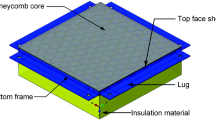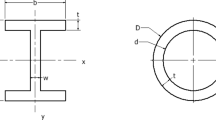Abstract
This work examines the possibility of using some classical optimization methods (augmented Lagrange multiplier method) or genetic algorithms and neural networks to optimize the cooling regime in hot-rolled complex beam processing. The objective is to optimize the cooling conditions so as to minimize the residual stresses. A detailed example shows that using this stochastic method and neural networks can be efficient. In other words, this work involves finite element analyses of both mechanical and thermodynamic properties of cooling beams, neural networks, genetic algorithms, and optimization to find a cooling regime with minimum residual stresses.
Similar content being viewed by others
References
Ryu HB, Speer JG, Wise JP (2002) Effect of thermomechanical processing on the retained austenite content in a Si-Mn transformation-induced plasticity steel. Metall Mater Trans 33(9):2811–2816
Baligidad RG, Radhakrishna A (2001) Effect of hot rolling and heat treatment on structure and properties of high carbon Fe-Al alloys. Mater Sci Eng 308(1–2):136–142
Kim SJ, Lee CG, Lee TH, Lee S (2000) Effects of cooling temperature on microstructure and mechanical properties of high-strength hot-rolled steel plates containing Cu, Cr and Ni. ISIJ Int 40(7):692–698
Chen MY, Linkens DA (2001) A systematic neuro-fuzzy modeling framework with application to material property prediction. IEEE T Syst Man Cy B 31(5):781–790
Gitman MB, Pankratov AP, Trusov PV (1999) Stochastic optimization of the cooling conditions of hot-rolled long pieces. Russ Metall 4:45–50
Marcelin JL, Abouaf M, Chenot JL (1986) Analysis of residual stresses in hot-rolled complex beams. Comput Method Appl M 56(1):1–16
Marcelin JL (1983) Analysis of residual stresses in hot-rolled complex beams. PhD Thesis, Sophia-Antipolis, CEMEF, Ecole Nationale Superieure des Mines de Paris, France
Kusakabe T, Mihara Y (1980) Analysis of residual stresses in hot-rolled H shapes. Trans Iron Steel Inst Jpn 20:454–461
Baskiyar R (2001) A study of the implications of air cooling of hot-rolled asymmetrical sections. J Mater Eng Perform 10(1):53–55
Madsen LE (1981) Engineering design optimization by the augmented Lagrange multiplier method. Thesis, Naval Postgraduate School, Monterey, CA, USA
Fletcher R, Powell MJD (1963) A rapidly convergent descent method for a minimization. Comput J 6:163–168
Holland JH (1975) Adaptation in natural and artificial systems. University of Michigan Press, Ann Arbor
Koza JR (1992) Genetic programming: on the programming of computers by means of natural evolution. MIT Press, Cambridge
Goldberg DE (1989) Genetic algorithm in search, optimization and machine learning. Addison-Wesley, Boston
Berke L, Hajela P (1992) Applications of artificial neural nets in structural mechanics. Struct Optim 4:90–98
Szewczyk Z, Hajela P (1993) Neural network approximations in a simulated annealing based optimal structural design. Struct Optim 5:159–165
Szewczyk Z, Hajela P (1994) Neurocomputing strategies in structural design-decomposition based optimization. Struct Optim 8:242–250
Szewczyk Z, Hajela P (1994) Neurocomputing strategies in structural design—on analysing weights of feedforward neural networks. Struct Optim 8:236–241
Jodouin JF (1994) Les reseaux neuromimetiques. Hermes, Paris
Author information
Authors and Affiliations
Corresponding author
Rights and permissions
About this article
Cite this article
Marcelin, JL. Optimization of the cooling regime of hot-rolled complex beams. Int J Adv Manuf Technol 32, 711–718 (2007). https://doi.org/10.1007/s00170-005-0376-3
Received:
Accepted:
Published:
Issue Date:
DOI: https://doi.org/10.1007/s00170-005-0376-3




